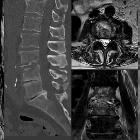schmerzhafte Skoliose

School ager
with back pain. AP radiograph of the thoracic spine (left upper) shows a mild curvature of the spine convex right and the left pedicle of the T12 vertebral body is difficult to visualize. Axial CT without contrast of the T12 vertebral body (right upper) shows a lesion with a lucent nidus surrounded by a sclerotic rim in the left pedicle of the T12 vertebral body. Pinhole (left lower) and whole body (right lower) images from a nuclear medicine bone scan show focally increased radiotracer localization in the left pedicle of the T12 vertebral body and a curvature of the spine convex right.The diagnosis was painful scoliosis secondary to an osteoid osteoma in the left pedicle of the T12 vertebral body.

Teenager with
back pain and lumbar scoliosis for 1 year. Sagittal T1 (above left) and T2 (above middle) MRI of the spine show an intramedullary tumor of the spinal cord extending from T10 to T12 that on sagittal T1 MRI with contrast (above right) shows heterogenous enhancement. Axial T2 MRI (below) better demonstrates the cord expansion caused by the tumor.The diagnosis was ganglioglioma of the spinal cord in a patient with painful scoliosis.

School ager
with cafe au lait spots and upper back pain. Coronal conventional tomogram of the thoracic spine shows a soft tissue mass in the apex of the right lung causing scalloping of the right side of the upper thoracic vertebral bodies and a scoliosis convex left.The diagnosis was a paraspinal plexiform neurofibroma causing painful scoliosis in a patient with neurofibromatosis Type 1.
schmerzhafte Skoliose
Siehe auch:
und weiter:

 Assoziationen und Differentialdiagnosen zu schmerzhafte Skoliose:
Assoziationen und Differentialdiagnosen zu schmerzhafte Skoliose:


